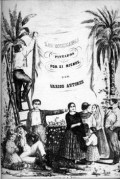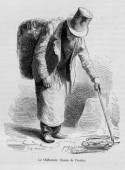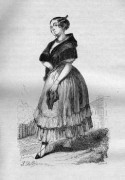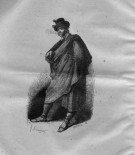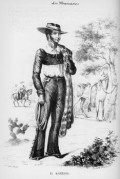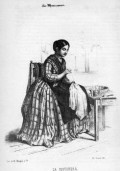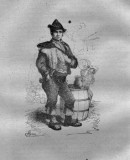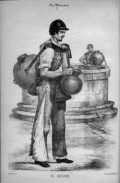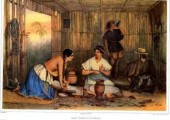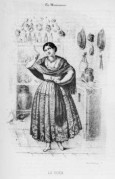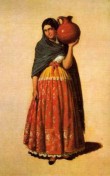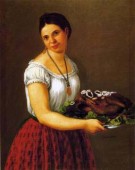The browser will either open the file, download it, or display a dialog.
European albums of popular types, such as Heads of the People or Les Français peints par eux-mêmes, are familiar to most nineteenth-century art historians. What is less well known is that in the 1850s Mexican writers and artists produced their own version of such albums, Los mexicanos pintados por sí mismos (1854–55), a compilation of essays and illustrations by multiple authors that presented various popular types thought to be representative of nineteenth-century Mexico (fig. 1).[1]Los mexicanos was clearly based on its European predecessors just as it was unequivocally tied to its costumbrista origins.
Costumbrismo, which manifested itself both in Spain and Latin America, was a movement in late eighteenth- and early nineteenth-century visual and literary arts that sought to capture the customs, costumes, and traditions of everyday people and everyday life. In Mexico, costumbrista artists and writers were concerned with depicting and describing their daily surroundings and the diverse population that inhabited the country during the post-independence period.[2]
Mexican costumbrista literary texts and visual imagery functioned within a larger, global discourse of nationalism and national identity. In this article, I shall argue that costumbrismo contributed to the construction and proliferation of racial and social popular types that were used by Mexico’s literary elite to position Mexico vis-à-vis other nations. Costumbrista texts and images created a propagandistic, subjective language of representation that celebrated nineteenth-century Mexican culture and traditions. To demonstrate this, I shall focus on Los mexicanos pintados por sí mismos, not only to establish its relationship to various European predecessors but also to demonstrate how its visual imagery and literary text functioned conjunctively in the formation of a new national subjectivity in post-independence Mexico.[3]
Existing publications on costumbrista art in Latin America are few; in English they are almost non-existent. The genre is often touched upon in survey exhibitions and texts on nineteenth-century Latin American art,[4] but the in-depth relationship between costumbrista images and nationalistic discourse has not received sufficient scholarly attention.[5] To construct my argument, I posit that at the core of costumbrista artistic production is a dialectic between norm and difference. In the mid-nineteenth century, Mexican costumbrista artists were constructing an image based on assumptions and stereotyping of what “all” Mexicans look like. Yet this very grouping of similarities was dependent on differences from others and isolation of things that are not Mexican. While typecasting constructs popular figures to fit a norm, the types, simultaneously, are organized into a classification based on difference.[6] This paradox, in which difference articulates uniqueness and particularity and yet also imparts principles of similitude and sameness, is embedded in costumbrista works.[7]
Costumbrista artists and writers attempted to formulate a national identity based on notions of similarity to, and difference from, European nations. John Plamenatz theorizes two types of nationalism: a western type having emerged primarily in western Europe, and an eastern type found in eastern Europe, Asia, Africa, and Latin America.[8] In the western type, a nation may have felt at a disadvantage in comparison with others when measured by universal standards of progress, but there was no sentiment that the nation was not culturally equipped to reach and surpass those standards. Eastern nationalism, on the other hand, occurred among nations that were drawn into a civilization that was foreign to them. These nations measured their progress against standards that had been imposed by the alien culture. According to Plamenatz, the nation had to be transformed culturally, but if it simply imitated the dominating foreign culture it would lose its distinguishable identity. Thus, the search was for a revitalization of the national culture, adapted to the standards of progress, but preserving at the same time its distinctiveness. In eastern nationalism, as defined by Plamenatz, formulating a national identity involved attaining an ambiguous middle ground between complete acceptance (imitation) and total rejection of the values imposed by the foreign culture. Plamenatz states, “In fact, [there are] two rejections, both of them ambivalent: rejection of the alien intruder and dominator who is nevertheless to be imitated and surpassed by his own standards, and rejection of ancestral ways which are seen as obstacles to progress and yet also cherished as marks of identity.”[9]
The equivocal rejections that Plamenatz articulates are visible in nineteenth-century Mexican costumbrista art and literature. Although this article does not provide an exhaustive analysis of all the types presented in Los mexicanos pintados por sí mismos, the three that I discuss in detail, the aguador (water-carrier), the ranchero (rancher), and the china poblana,[10] demonstrate characters that were embraced for their uniqueness to Mexican culture, while undoubtedly associated with European types.
European Collections of Types
Antecedents of nineteenth-century collections of types such as Heads of the People, Les Français peints par eux-mêmes or Los mexicanos pintados por sí mismo, may be found in eighteenth-century costume books and in the common genre of “Cries,” collections of images of street vendors, with captions that reproduce their “cries” (“old chairs to mend!”).[11] Both had their origins in Europe and were widely circulated. At the heart of the costume books and, to a lesser degree, the “Cries,” was the eighteenth-century understanding that clothing was an essential marker of difference. Unlike today, it was not an expression of style or fashion, but a sign of gender, age, marital status, occupation and social rank, in addition to nationality.[12] Dress, to a large degree, was standardized and could be rationally classified.[13] This made it possible to identify a person by his or her clothes. In a time of restricted social and geographic movement, these publications provided access to other social classes as well as other lands.
In the nineteenth century, the interest in types acquired a national rather than an international focus, seen in the popular images and literature of the period, including songs, magazine articles, and books, that endlessly engaged with various local social types. A series of short books called physiologies, popular in the 1840s, as well as Les Français peints par eux-mêmes, may serve as examples.[14] Even academic artists, such as Edouard Manet, portrayed gypsies, ragpickers, and musicians in his desire to reflect his own world and express his own age. Several of these works resemble figures in the albums of types. Manet’s Chiffonnier or Ragpicker (1869, Norton Simon Foundation) for instance, shares numerous affinities with Charles Joseph Traviès’s portrayal of the same subject illustrated in Les Français peints par eux-mêmes (fig. 2).
England was the first to publish an album of types, Heads of the People, in 1841.[15] The principal objective of Heads of the People was to record the features and characters of its people and to preserve an image of the time.[16] As stated in its preface, “English faces, and records of English character, make up the present volume . . . the aim of which is to preserve the impress of the present age; to record its virtues, its follies, its moral contradictions, and its crying wrongs.”[17] Its goal was to offer, through sarcasm and humor, a moralizing message that would encourage its audience to be self-reflective. The success of the volumes was immediate and its critics wanted to see an expansion of types, a broader representation of the national spirit.[18] The publication was soon translated into French with the new title, Les anglais peints par eux-mêmes. The change in title demonstrates the desire on the part of the French to clarify who was being represented (and critiqued) by whom, and it became very much identified, in subsequent versions, with the nation itself and utilized as a proud promoter of national identity. Many of these albums preceded the international expositions which began with the Crystal Palace exhibition in Hyde Park, London, 1851, in which nations competed for primacy and, in a similar way, became self-consciously reflective as they were trying to establish the way in which they were different from, and perhaps superior to, other nations.
The Spanish Los españoles pintados por sí mismos, published in 1843, includes a self-reflective introduction that acknowledges the challenge of selecting types representative of what constitutes Spanish people, culture, and customs.[19] It recognizes the inevitable influences of foreign cultures, particularly that of France, and the challenge of preserving the purity of one’s cultural identity. The Peninsular War and the French invasion of Spain (1808–14) had occurred only three decades earlier. Thus, Los españoles clearly articulates the nationalistic aims of its project and proudly claims and, in some cases, reclaims certain types as typically Spanish. Ironically, the Spanish writers who contributed to Los españoles imitate the French collection of types in their quest for Spanish nationalism. For example, the anonymous author of the introduction states:
Here as if cast into a mold we experience a sense of regret over our old traditions, so mixed up, so unknown today, due not only to the revolutions and the political upheavals, like some would say, but also to the foreign spirit that for years has been dominant. This causes us to abandon our clothes and our purely Spanish character for the character and clothes of other nations, to whom we pay the most burdensome tribute; that of primitive nationality.[20]
Characters such as la Maja (fig. 3)[21] or el Torero (bullfighter) (fig. 4) that had been exploited by European romanticism were recaptured and recast as emblematic Spanish types. The authors discuss identity in terms of an identity now lost. For example, after describing nostalgically the dress of the majas and their simple, working-class origins, the writer of the text, Santa Ana, directly blames the French invasion of 1808 for the negative transformation of these impoverished majas into the opulent, unscrupulous creatures of the nineteenth century.[22] By sharing the tragic story of the maja, the author historicizes and romanticizes the fictive maja of the past.
Costumbrismo in Latin America
The collection of types produced in Mexico was linked to the costumbrista movement, which was in fact not limited to Mexico, but rather was prevalent throughout Spain and Latin America.[23] It is an umbrella term that includes literature as well as the visual arts. The essays by costumbrista writers were often referred to as cuadros de costumbres (pictures of customs) or bosquejos (sketches), terms that imply there is a visual component to this type of writing. By describing in words what one sees, the author compels the readers to imagine or visualize a picture in their mind. In that sense, the visual component is inseparable from the text. In fact, cuadros de costumbres were often accompanied by an illustration that served to complement the written description, though often the writing style was so descriptive and elaborate that an image was not necessary. In Mexico, lithography became the medium of choice for the illustrations that accompanied cuadros de costumbres.[24] These essays were published in periodicals during the 1840s, and eventually in collections of types and novels.[25] During the 1850s, artists also produced paintings in the costumbrista tradition, and found a market for their work through the biennial exhibitions held at the Academy of San Carlos.[26]Costumbrista literary texts, lithographs, and paintings are not individual strings of ideas and stereotypes, but a mosaic of impressions that constantly intersect, informing and clarifying one another—a never-ending cycle of intertextuality.[27]
Los mexicanos pintados por sí mismos
Los mexicanos pintados por sí mismos shares many similarities with its European predecessors, particularly the Spanish edition that most closely resembles its format. However, there are also many interesting differences, such as the unique types that were selected and the accompanying narratives full of colloquial expressions (figs. 5, 6). What sets the Mexican album apart is that in its selection of popular types, which included those that could be found in Europe as well as those unique to Mexico, it stressed both similarity to, and difference from, the European collections. The ultimate objective, as we shall see, was to put forth types that demonstrate Mexico’s distinctiveness while not deviating too far from the European norm.
Los mexicanos was published in serial form beginning in 1853 and eventually in its entirety as a book in 1854–55. It featured thirty-three types. In the frontispiece of the album, a preview of the types of Mexicans included in the book can be seen in the various groupings of archetypal figures (fig. 1). The participating authors included Hilarión Frías y Soto, Niceto de Zamacois, Juan de Dios Arias, José María Rivera, Pantaleón Tovar, and Ignacio Ramírez, though at the time of publication these authors signed their works using pseudonyms.[28] Lithographs were produced by Hesiquio Iriarte and Juan Campillo. Each narrative is accompanied by one full-size illustration of the figure, often in an undefined setting, but almost always carrying the tools or attributes of his or her trade. Certain types, such as the ranchero or china poblana, were uniquely tied to Mexican culture, but the selected types were not restricted to just people or occupations found in Mexico. For example, also included were universal types, such as the seamstress, the lawyer, and the poet, that also appeared in European collections (fig. 6). Presenting a balance between popular types unique to Mexico and popular types that were characteristic of many nations validated Mexico as an independent nation and a participant on the global stage.
A notable aspect of Los mexicanos that demonstrated a desire to not diverge too far from the norm is the absence of African types. Africans were one of three main groups (the others being Amerindians and Spaniards) that had inhabited Mexico since the colonial period. Large numbers of Africans had come to Mexico as part of the Atlantic slave trade in the sixteenth through eighteenth centuries.[29] Miscegenation among these three groups, known as castas, produced a complex and fluid multiracial and multicultural society. In the eighteenth century, Africans were represented in casta paintings, a genre that visually represented the hierarchical arrangement of colonial Mexican society through familial arrangements.[30] Ideas of racial purity and racial degeneration were evident in the serial nature of the paintings, with white Spaniards occupying the top of the social and racial ladder, followed by various combinations of Spaniards, Africans, and Amerindians.
The popular types that are included in Los mexicanos, however, are mainly mestizos (Indian and Spanish), criollos (Spaniards born in the Americas), and Amerindians, with a clear emphasis on the mixed class of mestizos. Independence in 1821 brought the rejection of casta nomenclature, and eventually, in 1829, the abolition of slavery. As Claudio Lomnitz has argued, racial dynamics in the nineteenth century were simplified into a bipolar model of Indians and whites with an intermediate class of racially mixed mestizos.[31] The multiple racial categories that composed the sistema de castas in the colonial period, changed in the nineteenth century, essentially disappearing the black presence from visual narratives. The Mexican album seems to emphasize the mestizo, a mixed race that effectively occupies the ambiguous middle ground that Plamenatz theorizes.
The stories included in Los mexicanos frequently feature the author as an actor in the narrative, or use dialogue to convey local dialects and colloquialisms, establishing a sense of authenticity. The active presence of the author in many of the texts, however, does little to evoke the sense of testimony to real-time events, and instead imparts an imaginary, fictive, and subjective presence. An example of this can be found in the chapter on el aguador (water-carrier), a quintessential Mexican type, extensively described and depicted by traveler-writers such as Brantz Mayer and traveler-artists such as Claudio Linati and Edouard Pingret.[32]
El aguador was featured in Los mexicanos as well as in the Spanish collection, Los españoles pintados por sí mismos. Although the two figures represent the same occupation, they are distinguished by their costumes and poses. The Spanish aguador has a dark complexion and is short in stature. His simple clothing and inactive stance contribute to his rough, gruff appearance. He wears a triangular hat, a short jacket, trousers, and working boots (fig. 7).[33] Both hands are hidden from view; the left hand is under his vest, the right in his pants pocket. He is depicted standing still, not in the act of transporting water. Behind him is a small sketch of a water-carrier who carries a large wooden barrel of water on the upper part of his back and shoulders, sustaining it by its handles with both arms. In contrast, the Mexican aguador is distinguishable by his upright position, his clean clothes, and kempt look (fig. 8). The Mexican aguador is depicted as a mestizo with dark hair and eyes. His round cap and the two clay receptacles he carries, one on his back and the other in front of him, strapped around his chest, identify his profession. Presumably under tremendous strain due to the weight of his wares, he shows no signs of distress, but proudly stands in front of the central well at which a companion is filling up his own barrels. The Mexican aguador is dressed in a white shirt with sleeves rolled up above his elbows. His pants are made of two fabrics that are buttoned on the sides, similar to those of the ranchero, or rancher.[34]
The text by Abenamar of the Spanish aguador is written in the third person and describes the aguador’s task as an inevitable result of the hierarchy of social classes.[35] The aguador comes from Asturias or Galicia, less fashionable areas of Spain, to Madrid to serve the upper classes who can afford to hire someone to bring them the most essential necessity on earth, water. Although Abenamar quotes a conversation between the aguador and his wife in which he regretfully informs her that he must leave for Madrid in order to find work, Abenamar does not insert himself into the text as a participant. The emphasis is on the hardship and poverty of the aguador.
By contrast, in the Mexican text, Hilarión Frías y Soto describes his direct encounter with the aguador delivering water to his house, and records several conversations between them. As the aguador silently approaches, the author calls out to him, “Come here Trinidad. . . . Sit down in this chair and tell me about the life you lead.”[36] Trinidad respectfully declines; he has a full day’s work in front of him and if he is delayed his patrons will be angry. Furthermore, he says: “Besides, master, why tell you about my life, I don’t know for what that would serve, sir.”[37] The italics are original to the Spanish text and emphasize the shortened pronunciation that would have occurred in the vernacular Spanish spoken word, i.e., the shortened “pa” for “para.”[38] The aguador openly questions why anyone of the author’s profession and class would want to know about his life? To which the author responds, “Imagine son, today we Mexicans are painting ourselves, do you understand?”[39] This dialogue directly voices the sense of pride and ownership that the Mexican authors assume in writing about their own people. It was no longer acceptable to be described by traveler-artists and writers.
Visual and written representations describing the people and places of the New World had multiplied since Alexander von Humboldt’s travels to the New World in the early nineteenth century.[40] These representations, such as the German artist Carl Nebel’s sensual and erotic image of a partially nude mestiza woman in Las Tortilleras (fig. 9), were critically viewed by Mexican costumbrista writers as exoticizing their subject. Mexicans set out to write about their compatriots in a more dignified manner, even if those compatriots came from the lower classes, such as the aguador. It is also important to note that the people doing the describing are members of the hombres letrados, a small elite class of literary men who sought to position Mexico as a cultured and civilized society.[41]
The aguador is the opening chapter of Los mexicanos and poignantly identifies the album’s objective, especially important since the collection does not include a separate introduction. The author informs Trinidad that it is his job to tell the world about his customs, his habits, his vices, his qualities, so that everyone gets to know him, Accessing and recording the aguador’s true voice provides the reader with the most “truthful” representation. Trinidad promises to return at midday to tell the author everything he wants to know. The aguador is described throughout this narrative as an uneducated but hardworking, honest man; a good father, a “not so bad” husband, and a “priest of Neptune.”[42] The aguador eats simply, celebrates various festivals with his friends and family, rarely drinks to excess, and always carries himself with dignity.
In the course of the text devoted to the aguador, the author is interrupted by a hard knocking on his front door. Trinidad enters with only the ropes of his clay barrels strapped around his body, his clothes tattered, his face pale and his lips bloodied. Urged to explain what has happened, Trinidad recounts how he had reluctantly agreed to deliver love letters for a young, virtuous girl and her lover, a lower class rogue, when the girl’s father discovered him handing over the love note. The father snatched the letter and sent Trinidad stumbling down the stairs, shattering his barrels, water splashing everywhere. Trinidad escaped the father’s wrath by rushing over to the author’s home, requesting that the author accompany him to the courts to write a letter on his behalf explaining his story, to prevent him from going to jail. The author concludes, “I gathered my hat and left with Trinidad, very happy to be the apologist and patron of the Aguador. Mexico, September 27, 1854.”[43]
This is a curious place to end the short story, but it reveals the style and mission of these cuadros de costumbres. By inserting himself into the dialogue and concluding in this cursory manner, the author succeeds in evoking a “slice of life” sensation. It is as if he were writing in his journal and capturing the day’s activities as they were happening in real life. The aguador’s illiteracy, poverty, and working class status is compared and contrasted with the author’s financial means, his literacy, and upper social class. As the aguador’s representative, a role the author is proud to assume, it seems as if the declaration at the beginning of the story that the world must know what all Mexicans do and who they are, is reasserted in the two figures’ solidarity.
Another quintessential Mexican type, and one popular among both costumbrista artists and writers, was the ranchero or rancher (fig. 5). Rural rather than urban, the ranchero typically was virile, gallant, and courageous. He was usually of mixed races, either a mestizo or a mulatto (African and Spanish).[44] The rancher in Los mexicanos pintados por si mismos, is depicted with a medium-dark complexion suggesting a mestizo man. In the essay written by José María Rivera, the author travels to a ranch at the invitation of a friend, Don Alonso. There he witnesses a bullfight in which Don Alonso’s sons confront and fight becerros, or young bulls, for the entertainment of the author and the women of the ranch. A conscious connection to Spain and its popular type of the torero, or bullfighter, is made. But Mexicans preferred the ranchero over the torero. Unlike the torero, the ranchero is linked to the land, and while the bulls are occasionally used for entertainment, it is in the ranch’s economy that they truly play their part.
In his lively account of his visit to a ranch, Rivera not only watches, but also participates in the bullfighting. He comically recounts how, in the process of riding the bull, he experiences embarrassment as he loses his pants and is thrown from the bull. By telling the story in the first person and recounting his participation in the bullfight, the author lends authenticity to the story.
If the aguador was representative of Mexican honesty, industriousness, and compassion, and the ranchero of virility and masculinity, la china was emblematic of Mexican feminine beauty, charm and passion (fig. 10). José María Rivera’s cuadro de costumbre of “La China. restates the collection’s goal of Mexicans painting Mexicans, and although, he says, there are many distinguished Mexican women one could write about, he wants to focus on one beautiful woman who is Mexican through and through. He calls out, “Go away! Go away all of you high- class people! Away with the Spanish majas and manolas[45] and the French grisettes![46] I repeat, go away! Because now comes my china; that daughter of Mexico that is as beautiful as the blue sky, as fresh as the flower gardens and as pleasant and cheerful as the wonderful mornings of this blessed land of God and his saints.”[47] If one were a writer, Rivera claims, one might think la china is the Mexican version of the Spanish maja. If one were a scholar, one might think la china is a bad sketch of the Spanish manola. But, he states, “For me, as I am neither erudite nor learned, the china is the legitimate and beautiful daughter of Mexico . . . who at this moment is my only inspiration.”[48] By pointing out the similarities with the maja and the grisette, Rivera demonstrates the china’s clear associations with European types, while emphasizing the china’s unique personality traits and costume as Mexican through and through.
The china or china poblana, the consummate female character that was typified, idealized, and romanticized in Mexico was a popular subject among costumbrista artists and writers alike.[49] The term china derives from the Quechua word for servant, while poblana refers to a woman from the pueblo, or village. The term china poblana in the nineteenth century was generally meant to connote a mestiza who was from the provinces and wore a traditional, colorful costume. Images typically emphasize her distinguishing features: black hair, small waist, dainty feet, seductive curves, full skirt, and rebozo, or shawl (figs. 11, 12).
In Los mexicanos, the heroine’s name is Mariquita. She is depicted in the essay and the accompanying illustration as a mestiza, with dark hair and eyes. While holding her left hand suggestively against her hip, her right hand holds a cigarette.[50] She is portrayed in a kitchen interior, identifiable by the pots and pans adorning the walls. She is a complex character, beautiful and flirtatious, but also proud and independent. Inserting himself into the narrative, Rivera recalls an interview with his heroine in her home. He discovers that Mariquita is twenty-three years old, single, has no family, and lives alone. The author admires her charms, her jet black eyes, her curvaceous figure, and her tiny, exquisite feet. He notices and approves of the simplicity and cleanliness of her home. After the interview in Mariquita’s home, the author takes us to a party, where villagers are dancing the fandango.[51] There the china enchants many suitors with provocative moves, enticing them by flirting with her eyes and body. The dance ends with a fight between two of her suitors. In defense of her love interest, she inserts herself into the melee and ardently struggles to break the men apart, revealing her hot temper and combative and feisty personality. In her move from the private domesticity of the home to the public realm of the dance, the china displays both innocence and worldliness. In the end, the author pays tribute to the china not just for her feminine beauty and charm, but also for her fiery, courageous, and independent spirit.
Los mexicanos pintados por sí mismos presents thirty-three types as representative of Mexican society. By including autochthonous local figures like el aguador, el ranchero, and la china, Los mexicanos embraces the lower mixed-race classes and makes assertions of originality and authenticity. By incorporating universal types such as the lawyer, the minister, and the poet, Los mexicanos makes claims of solidarity with other nations, asserting that Mexico is also comprised of many of the popular types that can be found elsewhere.
Conclusion
According to Benedict Anderson, it was through “print-capitalism” that nations were imagined into existence.[52] Print-capitalism, the growth and marketing of indigenous newspapers and publications, was key to the growth of nationalism. The expansion of the book market contributed to the vernacularization of languages, which enabled speakers of the same language to become aware of one another via print and paper.[53] Print-capitalism enabled larger groups of people to think about themselves, about who they were, and in particular, their relation to others, both geographically and culturally. Costumbrista literature and art were forms of Anderson’s print-capitalism as they created unified fields of exchange and communication. In their representations of their surroundings and their people, costumbrista artists were making decisions on what was meaningful to Mexican identity and the nation as a whole, and it was through costumbrista periodicals and novels that ideas and images of what constituted being a Mexican were conceived and dispersed.
Mexican costumbrismo was not an isolated phenomenon. Many countries in the nineteenth century were preoccupied with establishing a national identity, and the artistic and literary creation of popular types contributed to this nationalistic discourse. Through the compilations of types, such as Heads of the People, Les Français, Los españoles, and Los mexicanos, artists and writers attempted to situate and position themselves vis-à-vis others.
As Mexican artists produced their own literary and visual compilation of popular national types, they were clearly influenced by European precedents. By acknowledging a connection with European models, Mexican artists registered their understanding that European cultures were similarly invested in claiming distinct types as part of their own national identities. The selection of popular types in Los mexicanos not only reflected local trends and visual traditions, but also played a part in national identity formation and constructed a view of how Mexico’s literary elite wished to present their newly formed nation. The Mexican album reveals a simultaneous desire to assert originality and authenticity, as well as normality and equality in comparison to Europeans. It was through costumbrista albums like Los mexicanos pintados por sí mismos that racial and social popular types were conceived and disseminated, and notions of modern Mexican identity were formulated.
All translations are by the author unless otherwise noted.
[1]Los mexicanos pintados por sí mismos: Tipos y costumbres nacionales, por varios autores (Mexico City: M. Murguía, 1854–55).
[2] Mexico received independence from Spain in 1821.
[3] This research is part of a larger project that examines various forms of costumbrista art and their relationship to the formation of a new national subjectivity in nineteenth-century Mexico.
[4] For example, see Angélica Velázquez Guadarrama, “Clase y género en la pintura costumbrista,” in Hacia Otra Historia del Arte en México, ed. Esther Acevedo (Mexico: Conaculta, 2001–2), 2:137–58; Gustavo Curiel, Fausto Ramírez, Antonio Rubial García, and Angélica Velázquez Guadarrama, Pintura y Vida Cotidiana en México, 1650–1950 (Mexico City: Fomento Cultural Banamex, 1999); Fausto Ramirez, “The Nineteenth Century,” in The Metropolitan Museum of Art, Mexico: Splendors of Thirty Centuries, exh. cat. (New York: Metropolitan Museum of Art, 1990); Dawn Ades, Art in Latin America: The Modern Era, 1820–1980 (New Haven and London: Yale University Press, 1989); and Fausto Ramírez, La Plástica del Siglo de la Independencia (Mexico: Fondo Editorial de la Plastica Mexicana, 1985).
[5] For this essay, I am indebted to scholarship by María Esther Pérez Salas. See Pérez Salas, Costumbrismo y Litografía en México: Un Nuevo Modo de Ver (Mexico City: Universidad Nacional Autónoma de México. Instituto de Investigaciones Estéticas, 2005).
[6] In theories of difference, difference is explained in relation to its opposite: sameness. When the word sameness is substituted by the word “identity” it becomes more complicated as identity and sameness can be both synonyms and antonyms of difference. As Mark Currie points out, “the dictionary defines identity as both 'absolute sameness’ and 'individuality’ or 'personality.’” The slippage derives from an ambiguity about the points of comparison and antithesis that are in operation. “Identity” can indicate the property of absolute sameness between separate entities, but it can also mean the unique characteristics determining the personality and difference of a single entity. The identity of people and nations is formulated by the logic of both sameness and difference. Mark Currie, Difference (London and New York: Routledge, 2004), 3.
[7] Ibid, 4–5, 13.
[8] John Plamenatz, “Two Types of Nationalism” in Nationalism: The Nature and Evolution of an Idea, ed. Eugene Kamenka (Canberra: Australian National University Press, 1973), 22–36.
[9] Ibid., 34.
[10] The china poblana was generally a mestiza, a woman of mixed Indian and Spanish parentage, who wore a traditional, colorful costume and came from the pueblo, or village.
[11] For example, Etudes prises dans le bas du Peuple, ou les Cris de Paris (Paris: Etienne Fessard,
1737); Cries of London (London: Colnaghi and Co., 1795); and Los gritos de Madrid (Madrid: n.p., 1798).
[12] Cesare Vecellio, The Clothing of the Renaissance World: Europe, Asia, Africa, the Americas; Cesare Vecellio’s Habiti Antichi et Moderni (London: Thames and Hudson, 2008), 16–19.
[13] Ulrike Ilg, “The Cultural Significance of Costume Books in Sixteenth-Century Europe,” in Clothing Culture, 1350–1650, ed. Catherine Richardson (Hampshire, UK: Ashgate, 2004), 42.
[14]Les français peints par eux-memes: Encyclopédie morale du dix-neuvieme siècle (Paris: L. Curmer, 1841–42).
[15]Heads of the People; or Portraits of the English, Drawn by Kenny Meadows (London: Robert Tyas, 1840–41).
[16] Ibid., preface.
[17] Ibid.
[18] Westminster Review 33, October 1840, 163, quoted in Margarita Ucelay Da Cal, Los españoles pintados por sí mismos (Mexico City: El Colegio de Mexico, 1951), 72–73.
[19]Los españoles pintados por sí mismos (Madrid: I. Boix, 1843–44), 1:vii.
[20] “Y aqui encajaba como de molde una sentida lamentacion acerca de nuestras viejas costumbres, tan trocadas, tan desconocidas hoy, merced no solo á las revoluciones y trastornos políticos, como algunos imaginan, sino tambien [sic] al espíritu de estrangerismoque hace años nos avasalla, y que nos hace abandonar desde el vestido hasta el carácter puro español, por el carácter y vestido de otras naciones, á las cuales pagamos el tributo mas oneroso; el de la primitiva nacionalidad.” Ibid.
[21] Term for woman or man (“majo”) from the lower classes who distinguished themselves by their elaborate sense of style and dress, which was an exaggeration of traditional Spanish dress. This style was in marked contrast to French fashions. In the present day, maja/majo is synonymous with nice or good looking.
[22]Los españoles, 2:59.
[23] However, in Latin America, Cuba was the only other country to produce its own collection of types. See Los cubanos pintados por sí mismos, Colección de tipos cubanos (Havana: Barcina, 1852). These volumes were generally first distributed in serial form and then subsequently published in book format.
[24] This was made possible by the Italian artist Claudio Linati, who had brought the first lithographic printing presses to Mexico in 1825. See Justino Fernández, introduction to Trajes Civiles, Militares y Religiosos de Mexico, by Claudio Linati (Mexico City: Universidad Nacional Autonóma de México, 1956).
[25] For example, the costumbrista writer, Tomás de Cuéllar, satirized various quintessential Mexican types during the long presidency of Porfirio Díaz in his novel The Magic Lantern. Tomás de Cuéllar, La linterna mágica (Barcelona: Tipolitografía de Espasa y Compañía, 1889.
[26] Mexico’s academy was founded in 1785 and was modeled after the academies of Madrid, Paris, and Rome.
[27] Roland Barthes, Image-Music-Text (London: Fontana Press, 1977), 146; and Julia Kristeva, “Word, Dialogue and Novel” in Desire in Language: A Semiotic Approach to Literature and Art, ed. Leon S. Roudiez (New York: Columbia University Press, 1980), 64–91.
[28] The authors were later identified and published in subsequent versions of Los mexicanos. See Los mexicanos pintados por sí mismos: Tipos y costumbres nacionales, por varios autores (Mexico City: Manuel Porrúa, S.A. 1949).
[29] See Aguirre Beltrán, La población negra de México: Estudio etnohistórico (Mexico City: Fondo de Cultura Económica, 1972), 220–34.
[30]Casta paintings presented racially mixed families on a series of canvases. Often depicted were a father and mother of different races (Spanish, Indian, or Black, or some combination thereof) and one or two of their mixed race offspring. Accompanying the visual portrait was text clarifying the subjects’ casta, that is their “lineage,” “breed,” or “race.” Twelve to sixteen panels often comprised a casta series with the most pure, meaning the “whitest” races occupying the top category that initiated the series. See Ilona Katzew, Casta Painting: Images of Race in Eighteenth-Century Mexico (New Haven and London: Yale University Press, 2004); Magali Carrera, Imagining Identity in New Spain: Race, Lineage, and the Colonial Body in Portraiture and Casta Paintings (Austin: University of Texas Press, 2003); and María Concepción García Sáiz, Las castas mexicanas; Un género pictórico americano (Madrid: Olivetti, 1989).
[31] See Claudio Lomnitz-Adler, Exits from the Labyrinth: Culture and Ideology in the Mexican National Space (Berkeley: University of California Press, 1992), 276–77.
[32] See Brantz Mayer, Mexico as It Was and as It Is (New York: J. Winchester New World Press, 1844), 43; Claudio Linati, Trajes Civiles, Militares y Religiosos de México (1828) (Mexico City: Universidad Nacional Autónoma de México, 1956), plate no. 7; and Luis Ortíz Macedo, Edouard Pingret: Un pintor romántico francés que retrató el México del mediar del siglo XIX (Mexico City: Fomento Cultural Banamex, 1989), 85.
[33]Los españoles, 139–43.
[34]Los mexicanos, 1–6.
[35]Los españoles, 139–43.
[36] “Ven acá Trinidad . . . Siéntate en esa silla y cuéntame la vida que llevas.” Hilarión Frías y Soto, “El Aguador,” in Los mexicanos, 2.
[37] “Además, amito, que eso de decir mi vida, no sé pa qué le pueda servir á su mercé.” Ibid.
[38] Ibid.
[39] “Calcula, hijo, que hoy los mexicanos hemos dado en pintarnos á nosotros mismos: ¿comprendes?” Ibid.
[40] Humboldt traveled in the Americas from 1799 to 1804 and lived in Mexico the final year of his excursion from 1803–4.
[41] These learned, lettered men were associated with the institutions of state and nation building in Latin America. See Angel Rama, La Ciudad Letrada (Hanover, NY: Ediciones del Norte, 1984).
[42]Los mexicanos, 3.
[43] “Tomé mi sombrero y salí con Trinidad, muy contento de ser apologista y el apoderado del Aguador. México, 27 de Setiembre de 1854.” Hilarión Frías y Soto, .El Aguador” inLos mexicanos, 6.
[44] The racial makeup of rancheros is discussed in the costumbrista article: José María Rivera, “Los Rancheros,”El museo mexicano (Mexico City: Ignacio Cumplido, 1843–44), 3:551.
[45] A colloquial derivation of the name Manuel, manola referred to the popular classes in Madrid similar to the maja. Manolo can also be synonymous with handsome or pretty.
[46] In nineteenth-century France, a young working-class woman of loose morals.
[47] “!Fuera¡ !Fuera la gente de alto rango¡ !Fuera las majas y manolas de España y las grisetas de Francia¡ . . . !Fuera repito¡ Porque ahora sale mi china; esa hija de México tan linda como su cielo azul; tan fresca como sus jardines floridos, y tan risueña y alegre como las mañanas deliciosas de esta tierra bendita de Dios y de sus santos.” José María Rivera, “La China,” in Los mexicanos, 90.
[48] “Para mí que no soy ni erudito ni literato, la china es la legítima y hermosa hija de México . . . que en este instante es mi única inspiración, mi solo númen.” Ibid.
[49] See Nicolás León, Catarina de San Juan y la China Poblana (Puebla: Altiplano, 1971), 65–67; Rafael Carrasco Puente, Bibliografía de Catarina de San Juan y la China Poblana (Mexico City: Secretaria de Relaciones Exteriores, 1950); and Jeanne L. Gillespie, “Gender, Ethnicity and Piety: The Case of the China Poblana,” in Imagination Beyond Nation: Latin American Popular Culture, ed. Eva P. Bueno and Terry Caesar (Pittsburgh: University of Pittsburgh Press, 1998), 19–40.
[50] Smoking was a common pastime of women of both the upper and lower classes. For example, see Brantz Mayer’s written account in México, lo que fue y lo que es (Mexico City: Fondo de Cultura Económica, 1953), 76; and Nicolás León, Catarina de San Juan y la China Poblana (Puebla: Altiplano, 1973), 83.
[51] A lively Spanish dance in triple time that is usually performed by a man and woman to the accompaniment of guitar and castanets.
[52] Benedict Anderson, Imagined Communities: Reflections on the Origin and Spread of Nationalism (London and New York: Verso, 2006., 36.
[53] Ibid.


